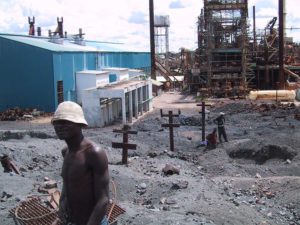This guest post is from Ben Barber, who visited Kabwe with the Blacksmith for a Pure Earth team in July.

We arrived last July in one of the world’s most toxic hotspots — Kabwe, a city of about 200,000 just two hours drive north of Zambia’s capita Lusaka.
We checked into the Elephant Head Hotel, most likely built during British rule when Zambia was known as Northern Rhodesia. At first, during a quick walk around the center of the city, it was hard to notice anything really out of the normal.
Shoppers wound their way through the markets and past sidewalk vendors of everything from newspapers to fruits and vegetables to cellphone cards. A friendly and active buzz of activity made me forget that the city contains a huge lead smelter and mine. They have been shut down for more than 10 years, but their legacy slowly became clear as we walked the sandy streets of the neighborhoods near the closed mine.
I went with a small team of three colleagues from the Blacksmith Institute, also known as Pure Earth, a New York-based non-profit that identifies and then helps clean up toxic waste sites in developing countries that contain lead, mercury, chromium, pesticides and other dangerous substances. We quickly made contact with local health and environment officials who arranged for us to test the blood of around 200 small children – to determine if the lead from the mine had been accumulating in the bodies of the most vulnerable residents.
The next morning we arrived at a tidy little cinderblock clinic. Dozens of anxious and friendly parents held their children close at hand, eager to get their blood tested for lead.
A Zambian health worker and a Blacksmith health expert pricked the tiny fingers. Some screaming ensued but tears dried up quickly when each kid got a piece of candy. The team quickly drew blood samples into sterile containers. I was assigned the task of wiping away excess blood and applying band aids.
After two or three hours in the packed and noisy clinic we found we had to turn away the mothers with their children who continued to arrive seeking a blood test.
In the afternoon, we began using a hand-held x-ray machine that tested soil for lead as well as other toxic substances. Following a pattern monitored by continuous geo spatial readings we prepared a list of readings. The soil readings were off the charts – hundreds of time above what health officials in Zambia and the U.S. consider acceptable and safe.
A local teacher in Kabwe, Wisdom Kuanda, wrote in a letter to the Zambia Daily Mail July 23 that “Kabwe is indeed one of the 10 most polluted towns in the world.”
“As a teacher I have observed poor memory retention in most of the pupils who were born in Kabwe as compared to those who just come on transfer. I have personally linked this problem to lead poisoning.
We saw the tailings – highly toxic piles of lead-rich ore that had been dumped over the nearly 100 years when the smelter was operation. These small hills of stone and gravel up to 50 feet high are the legacy that is getting into the children’s blood.
Just 50 feet from those tailing piles dozens of school children raced barefoot over a sandy football pitch, most likely unaware that they are picking up high lead from the dust all around them. Although 400 parts per million is the safe limit in Zambia, we found 10,000 to 15,000 parts per million.
We had been prepared to see the damage caused by lead poisoning but it was not easy to spot anything unusual. It was when we talked to nurses, teachers and parents that we learned how lead affects children there: it damages the developing neurological system, making it hard for children to learn and behave in a classroom.
Lead poisoning is often a silent disease – symptoms can be subtle such as degraded ability to learn, stomach upsets and other less-than- catastrophic effects.
So people continue to build houses near the mine, literally in the shadow of the towering slag piles. In Makalulu and other neighborhoods where thousands of children and adults lack resources to relocate, health teams told parents to prevent the children from playing outside. This has been inadequate and ineffective.
“This is a public health crisis – these are the highest blood lead readings I have ever seen,” said team member Dr. Jack Caravanos, Blacksmith/Pure Earth technical advisor and CUNY professor.
“Part of the population has acute lead poisoning, above the level that causes mental impairment.”
Lackson Mwanza , head teacher at the David Ramusho School, told me “dealing with lead will help improve mental capacity of the children.”
When we asked the parents if they knew about the danger from lead, most said they knew something but not enough to prevent their kids from getting lead into their bodies.
People are so poor in Kabwe that they had resorted to taking the lead tailings into their houses to try and extract some lead for sale.
And the government is considering reopening the smelter for a new run at lead production.
Gibson Chileshe, 62, was walking past the mine and told me “some of us are against reopening production at the mine, but people want jobs.” Many have registered to get a job if it reopens.
Related:
- African Lead Mine Poisons Children
- More about the Kabwe project





